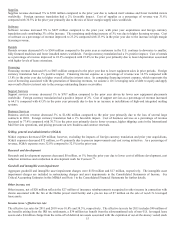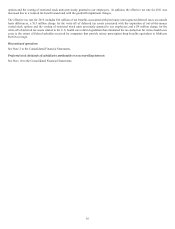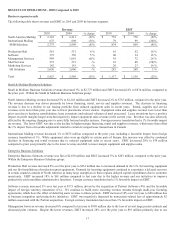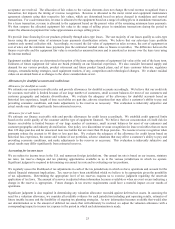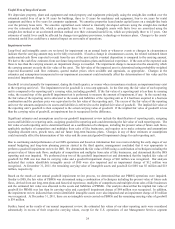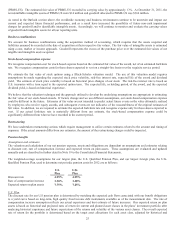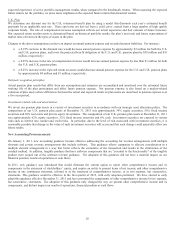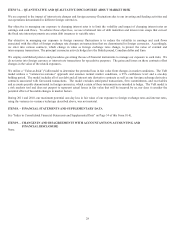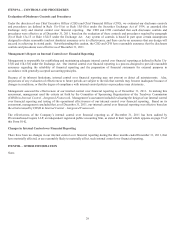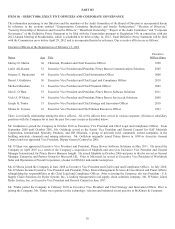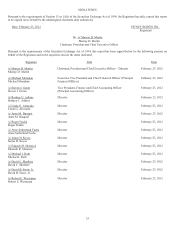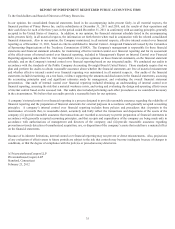Pitney Bowes 2011 Annual Report Download - page 43
Download and view the complete annual report
Please find page 43 of the 2011 Pitney Bowes annual report below. You can navigate through the pages in the report by either clicking on the pages listed below, or by using the keyword search tool below to find specific information within the annual report.
25
(PBMS-US). The estimated fair value of PBMS-US exceeded its carrying value by approximately 13%. At December 31, 2011, the
net identifiable intangible assets of PBMS-US were $14 million and goodwill allocated to PBMS-US was $364 million.
As noted in the Outlook section above, the worldwide economy and business environment continue to be uncertain and impact our
current and expected future financial performance, and as a result have increased the possibility of future non-cash impairment
charges for goodwill and/or identifiable intangible assets. Accordingly, we will continue to monitor and evaluate the carrying values
of goodwill and intangible assets for all our reporting units.
Business combinations
We account for business combinations using the acquisition method of accounting, which requires that the assets acquired and
liabilities assumed be recorded at the date of acquisition at their respective fair values. The fair value of intangible assets is estimated
using a cost, market or income approach. Goodwill represents the excess of the purchase price over the estimated fair values of net
tangible and intangible assets acquired.
Stock-based compensation expense
We recognize compensation cost for stock-based expense based on the estimated fair value of the award, net of an estimated forfeiture
rate. We recognize compensation costs for those shares expected to vest on a straight-line basis over the requisite service period.
We estimate the fair value of stock options using a Black-Scholes valuation model. The use of this valuation model requires
assumptions be made regarding the expected stock price volatility, risk-free interest rate, expected life of the award and dividend
yield. The estimate of stock price volatility is based on historical price changes of our stock. The risk-free interest rate is based on
U.S. treasuries with a term equal to the expected option term. The expected life, or holding period, of the award, and the expected
dividend yield, is based on historical experience.
We believe that the valuation technique and the approach utilized to develop the underlying assumptions are appropriate in estimating
the fair value of our stock-based awards. If factors change and we use different assumptions, our stock-based compensation expense
could be different in the future. Estimates of fair value are not intended to predict actual future events or the value ultimately realized
by employees who receive equity awards, and subsequent events are not indicative of the reasonableness of the original estimates of
fair value. In addition, we are required to estimate the expected forfeiture rate and recognize expense only for those shares expected to
vest. If our actual forfeiture rate is materially different from our estimate, the stock-based compensation expense could be
significantly different from what we have recorded in the current period.
Restructuring
We have undertaken restructuring actions which require management to utilize certain estimates related to the amount and timing of
expenses. If the actual amounts differ from our estimates, the amount of the restructuring charges could be impacted.
Pension benefits
Assumptions and estimates
The valuation and calculation of our net pension expense, assets and obligations are dependent on assumptions and estimates relating
to discount rate, rate of compensation increase and expected return on plan assets. These assumptions are evaluated and updated
annually and are described in further detail in Note 19 to the Consolidated Financial Statements.
The weighted-average assumptions for our largest plan, the U.S. Qualified Pension Plan, and our largest foreign plan, the U.K.
Qualified Pension Plan, used to determine net periodic pension costs for 2012 are as follows:
U.S.
Plan U.K.
Plan
Discount rate 4.95% 4.95%
Rate of compensation increase 3.50% 3.40%
Expected return on plan assets 7.75% 7.25%
U.S. Plan
The discount rate for our U.S pension plan is determined by matching the expected cash flows associated with our benefit obligations
to a yield curve based on long-term, high quality fixed income debt instruments available as of the measurement date. The rate of
compensation increase assumption reflects our actual experience and best estimate of future increases. Our expected return on plan
assets is based on historical and projected rates of return for current and planned asset classes in the plans’ investment portfolio after
analyzing historical experience and future expectations of the returns and volatility of the various asset classes. The overall expected
rate of return for the portfolio is determined based on the target asset allocations for each asset class, adjusted for historical and


